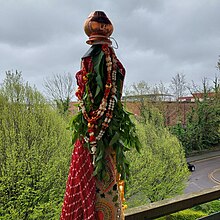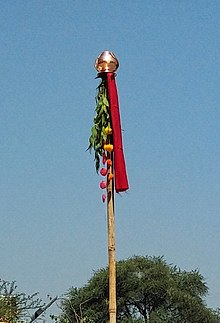
| Gudi Padwa | |
|---|---|
 A Gudi Padwa new year festive procession in Maharashtra | |
| Official name | Gudi Padwa |
| Also called | Marathi New Year, Hindu New Year |
| Observed by | Marathi and Konkani Hindus |
| Type | Religious (Hindu), social, cultural |
| Celebrations | 1 day |
| Observances | People clean and decorate their houses with colourful rangolis and Gudis. |
| Date | Chaitra Shukla Pratipada |
| Frequency | Annual |
| Related to | Ugadi, Cheti Chand |
Hindu festival dates The Hindu calendar is lunisolar but most festival dates are specified using the lunar portion of the calendar. A lunar day is uniquely identified by three calendar elements: māsa (lunar month), pakṣa (lunar fortnight) and tithi (lunar day). Furthermore, when specifying the masa, one of two traditions are applicable, viz. amānta / pūrṇimānta. If a festival falls in the waning phase of the moon, these two traditions identify the same lunar day as falling in two different (but successive) masa. A lunar year is shorter than a solar year by about eleven days. As a result, most Hindu festivals occur on different days in successive years on the Gregorian calendar. | |
| Part of a series on |
| Hinduism |
|---|
 |
Gudi Padwa is a spring festival marking the start of the lunisolar new year for Marathi and Konkani Hindus.[1] It is celebrated in and around Maharashtra, Goa & Damaon at the start of Chaitra, the first month of the lunisolar Hindu calendar. The festival is characterised by colourful floor decorations called rangoli, a special gudi dvaja; which is a saari or dhoti or other piece of cloth garlanded with flowers, mango & neem leaves; a sugar crystal garland called gathi, topped with upturned silver or copper vessels. Celebration also includes street gathering, dancing & festive foods.[1][2]

In Maharashtra, the first day of the bright phase of the moon is called gudhi paadwaa (Marathi: गुढी पाडवा), pādvo (Konkani: पाडयो; Kannada: ಪಾಡ್ಯ; Telugu: పాడ్యమి, paadyami). Konkani Hindus variously refer to the day as sausāra pāḍavo or sausāra pāḍyo (सौसार पाडवो and सौसार पाडयो, respectively). Telugu Hindus celebrate the same occasion as Ugadi, while Kannada Hindus in Karnataka refer to it as Yugadi (युगादि/ ಯುಗಾದಿ). Sindhi people celebrate the day as Cheti Chand, it is observed as the emergence of the day of Jhulelal. Prayers are offered to Jhulelal, and the festival is celebrated by making delicacies like tahiri (sweet rice) and sai bhaji.[3]
However, this is not the universal new year for all Hindus. For some, such as those in and near Gujarat, the new year festivities coincide with the five-day Diwali festival.[4] For many others, the new year falls on Vaisakhi between 13 and 15 April, according to the solar cycle part of the Hindu lunisolar calendar and this is by far the most popular not only among Hindus of the Indian subcontinent but also among Buddhists and Hindus of Southeast Asia.[4]


